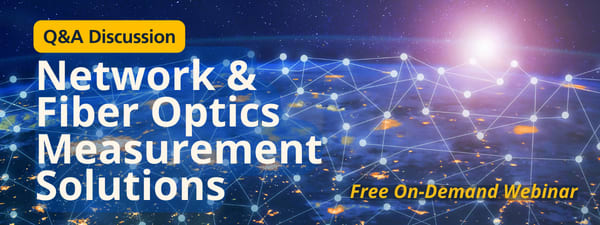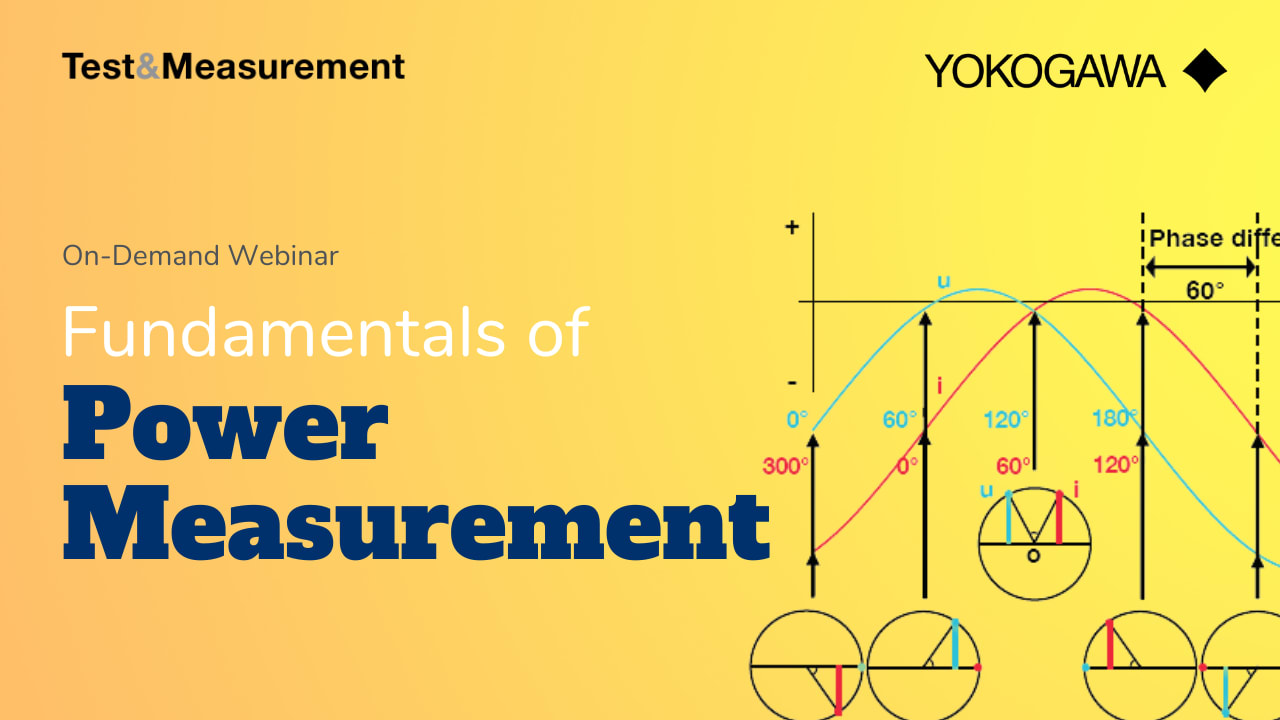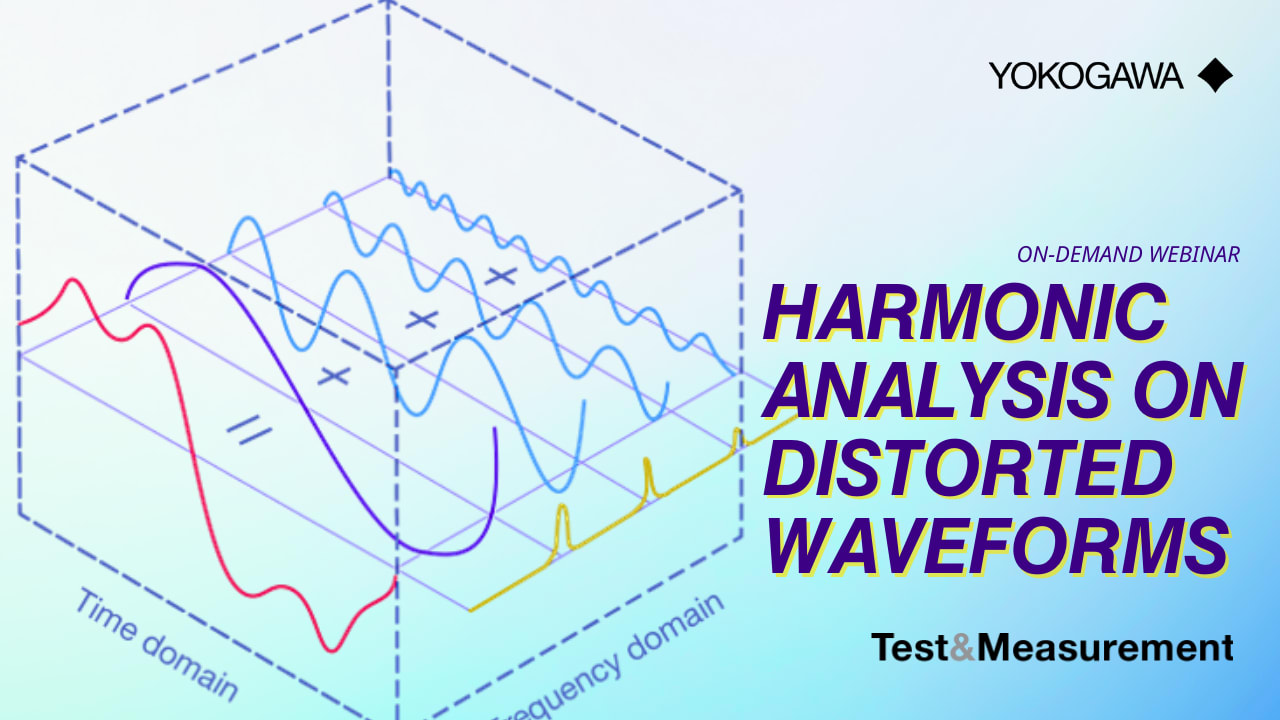-
Oscilloscopes
World-class digital oscilloscopes from Yokogawa: The digital oscilloscopes have high-speed sampling and a wide range of bandwidths that can be utilized for design and development of electronic devices. The ScopeCorders have the advantages of both a digital oscilloscope and a multi-channel data recorder.
-
Digital Power Analyzers
Yokogawa, the world's largest manufacturer of energy and power analyzers and meters, provides a broad choice of digital power analyzers to satisfy all requirements.
-
Data Acquisition Equipment
Yokogawa data acquisition systems give you the most flexibility and power to measure, display, store, and even actuate any number of physical or electrical phenomena.
-
Optical Test Equipment
Yokogawa offers solutions to measure both traditional and cutting-edge optical components and systems, serving the increasing demand for high capacity fiber lines, and new component technologies.
-
Generators, Sources
For general purpose standalone applications or as core components in a high speed test and measurement system, Yokogawa sources and signal generators are highly accurate and functional.
-
Portable and Handheld Instruments
Yokogawa's Portable and Handheld Instruments offer a broad range of portable test equipment to fulfill numerous short-term or continuous measurement application requirements.
-
Other Test and Measurement Instruments
Your test and measurements needs are broad and diverse and Yokogawa provides the right tools for your tasks with a variety of Controllers, Recorders, and Data Acquisition equipment.
-
Product Finder
This web tool makes it easier to find products according to the application, measurement conditions and required specifications.
Videos
There are countless technologies available for optical communications devices and systems validation. With so many specifics to take into consideration, it's not always easy for an engineer to determine the best networking and fiber optic measurement solution to address their measurement needs.
Key discussions in this on-demand webinar include:
- The what, why, and how of available options like optical spectrum analyzers, optical wavelength meters, optical power meters, variable attenuators, fixed and tunable laser sources, and more
- How to improve the quality and value of results for both active and passive optical devices
- Ways to streamline productivity and reduce costs while also achieving higher data transmission rates, longer-distance transmissions, immunity to EMI, lower signal loss, lower latency, enhanced security, and improved energy efficiency
- Trends driven by applications such as AI, quantum, and inter-satellite laser communications (i.e., space lasers!)
Continual improvements and innovations in motor and inverter technologies are key to furthering the goal of global decarbonization in the transportation industry.
During this webinar, engineering professionals who develop motor and inverter systems will learn how to more effectively benchmark data for and troubleshoot issues with energy efficiency in EV powertrains.
Key topics include:
- Baselines for system efficiency and inverter control signal analysis at the systems level
- Critical measurements to benchmark inverter input, inverter output, and motor output
- Analysis of motor control signals like torque control variables, positional sensors, and PWM and torque measurements
Increasing demands for greater network bandwidth and expansion of 5G wireless backhaul has driven data rates to 400G, 800G, and beyond. Starting with the physical layer of the optical network stack, precision measurement of these light speed signals is crucial.
This webinar covers a range of alternatives used to evaluate test parameters for DWDM, OSNR, SMSR, and EDFA, and includes a discussion on interesting applications like the use of high-energy lasers across space satellite mesh networks.
Key topics include:
- Key test methods and technologies
- Traditional and new applications
- Common testing oversights
- Measuring against industry standards
- Ensuring network element performance and reliability
With motors responsible for approximately half of the world's electric energy consumption, identifying opportunities to increase system efficiencies is more important than ever. Improving and innovating motor and inverter technologies is key to enable and further global decarbonization.
During this webinar, engineering professionals with a focus in design, systems, or testing of motor and inverter systems will learn how to more effectively benchmark energy efficiency through accurate power analysis.
Key topics include:
- Steps for precise high-accuracy power and energy measurements on an electric motor and inverter system
- Critical measurement points of inverter input, inverter output, and motor output in a motor and control system
- How voltage, current, and frequency translate into speed, torque, and power (output of the inverter and motor)
- Bringing it all together to effectively measure motor, inverter, and overall system efficiency
While DC power measurements are relatively straight forward, AC power measurements that include distorted waveforms, varying power factors, and multiple phases can add complexity to an otherwise simple measurement.
During this fundamentals webinar, Yokogawa Test&Measurement covers several power measurement subjects including multi-phase measurements, measurement techniques, measurement applications, real-world examples, and more.
You know the basics of electrical power measurements, have set up your dyno, and made key measurements – which is great. But as your motor and drive projects progress, the complexities of system drive requirements can change frequently. Control algorithms, networked communications, and mechanical systems form a complex web of interactions that need sorting. This 60-minute webinar explains how to get past ground-level measurements and delve into comprehensive solutions that leverage test and measurement instruments including power analyzers, high-speed data acquisition, and real-time software.
Topics include:
- How to avoid the “gotcha's” of inverter-based measurements
- Computations for field-oriented control
- The integration of CAN bus communications
- Correlations in the frequency domain
- Other advanced motor and drive topics
The technical presentation includes an audience Q&A.
As energy efficiency becomes an important consideration for governments, industries, and markets, engineers are looking to maximize product efficiency by optimizing power consumption and reducing losses in every process. Accurate measurement of power is an important element of quality control from the design phase all the way through to production and field operation.
Join us and let’s explore together some of the key factors in power measurements to help you get the best accuracy out of your measurements.
Key areas covered include:
- Understanding measurement, accuracy, and uncertainty (reading and range uncertainty)
- How is power measured?
- Other Influencers: Phase Shift (PF), CMRR, RMS vs Peak (Crest Factor), Temperature, External Sensors, Calibration and more.
- + Other considerations
Watch this webinar to learn how researchers and engineers can avoid relying on false or misleading results when using an optical spectrum analyzer.
While DC power measurements are relatively straight forward, AC power measurements that include distorted waveforms, varying power factors, and multiple phases can add complexity to an otherwise simple measurement.
During this power fundamentals webinar, Yokogawa Test&Measurement covers multiple fundamentals of power measurement.
Key topics include:
- Multi-phase measurements
- Measurement techniques
- Measurement applications
- Real-world examples and more
Why should you be concerned with your product’s power system voltage and current harmonics? From an engineering perspective, harmonics produce excessive heat in equipment that causes significant damage and results in inefficient operation. From a business perspective, compliance is an absolute requirement for entry into global markets. To minimize or eliminate these issues and establish acceptable levels of harmonics, numerous power quality standards with specifications and limits for harmonic distortion, such as IEEE 519-2014 and IEC61000-3-2, have been introduced. During this webinar, attendees will gain knowledge on the inner workings of harmonics, learn best practices for accurately measuring harmonics, learn to recognize and distinguish the critical difference between DFT and FFT, and discover important measurement tradeoffs across various test equipment.
A vision of self-driving cars propels the research and development of automotive LiDAR, a vital hardware providing distance and velocity information of a vehicle’s surroundings. Some LiDAR concepts are already heading toward production for automotive ADAS and industrial markets. Two newer concepts promise the greatest potential yet: frequency-modulated continuous wave (FMCW) LiDAR and time-of-flight (TOF) flash LiDAR. However, there are engineering challenges impeding their full adoption. This webinar reviews operation principles and challenges of different LiDAR concepts, a brief discussion on the LiDAR market, and a review of critical optical components such as photodetectors and sources.
Key takeaways include:
- Fundamental test solution principles for challenges in demanding environments
- Ensuring flawless and reliable operation of potentially life-critical components and systems over the entire life of the equipment
- Techniques and results of signals from both LiDAR and facial recognition lasers from different smartphones
- Experience how LiDAR manages (or mismanages) navigating metropolitan city streets in a truly driverless Level 4 Robotaxi
Mastering the fundamentals of optical wavelength measurements and having a solid understanding of measurement principles for optical sources and devices is key to measuring with confidence. This webinar provides a thorough review of these foundational elements and concepts as well as:
- Fiber identification and recommendations for routine care
- Measurement techniques for different optical measurement devices
- Example wavelength-specific applications for visible light to over 3000 nm such as telecommunications, biomedical, and atmospheric gas sensing
- Important considerations for selecting an optical spectrum analyzer
Adopting best practices in high-voltage measurement applications ensures more accurate results, safety for the equipment, and (most importantly) safety for the engineer. The isolation methodology needed for performing these measurements plays a critical role in selecting the right equipment and properly using the instrumentation.
Watch the recording for a discussion on the basics of high-voltage measurements and common isolation topologies. Additional topics include:
- Signal noise reduction and improved noise immunity
- Avoiding ground loops
- Analog vs digital isolation
- Protection for expensive equipment and the user
- Common-mode voltage and fluctuating ground potentials
News
-
Press Release Aug 30, 2018 Yokogawa Test & Measurement Releases Optical Sensor Head for the AQ2200
- A new model for measuring light in the short-wavelength region -
-
Press Release Dec 1, 2014 Yokogawa's PX8000 Precision Power Scope Named in EDN Hot 100 Products 2014
-
Press Release Nov 19, 2014 Passive Oscilloscope Probes Operate Over Wide Temperature Range
-
Press Release Sep 30, 2014 Yokogawa Corporation of America Releases New Multitasking, Modular OTDR with Capacitive Touchscreen
-
Press Release Jan 9, 2013 Yokogawa Meters & Instruments Releases WT310 and WT330 Series Digital Power Meters
Looking for more information on our people, technology and solutions?
Contact Us











